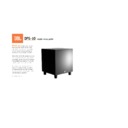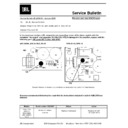JBL DPS 10 User Manual / Operation Manual ▷ View online
– 5 –
3) If your receiver/ampli-
fier has preamp output
jacks and main input
jacks for the left and
right channels or you
have a separate pre-
amp/processor and
power amplifier.
jacks and main input
jacks for the left and
right channels or you
have a separate pre-
amp/processor and
power amplifier.
This method of hookup can
offer the highest level of per-
formance for your complete
loudspeaker system. The
DPS-10 incorporates a
variable high-pass crossover
in addition to a variable
low-pass crossover. When
offer the highest level of per-
formance for your complete
loudspeaker system. The
DPS-10 incorporates a
variable high-pass crossover
in addition to a variable
low-pass crossover. When
hooked up as shown above,
the subwoofer will limit the
low-frequency information
that is returned to your
receiver/amplifier. Your
receiver/amplifier does
not need to waste valuable
power reproducing the low
frequencies. In addition,
since no low-frequency
information is being sent
to your main loudspeakers,
they are able to reproduce
mid and high frequencies with
greater clarity.
the subwoofer will limit the
low-frequency information
that is returned to your
receiver/amplifier. Your
receiver/amplifier does
not need to waste valuable
power reproducing the low
frequencies. In addition,
since no low-frequency
information is being sent
to your main loudspeakers,
they are able to reproduce
mid and high frequencies with
greater clarity.
RECEIVER/AMPLIFIER
MAIN SPEAKER OUTPUT
LEFT
RIGHT
RIGHT
+ –
RIGHT
LOUDSPEAKER
LEFT
+ – – +
– +
LEFT
LOUDSPEAKER
PRE
OUT
OUT
MAIN
IN
Line
SPKR
In
In
SPKR
Out
High-Pass
Output
Output
Input
L
R
L
R
+
–
–
+
+
–
–
+
High
Pass
Pass
Phase
60
180
0
180
120
90
150
Level
Min
Max
Low
Pass
Pass
60
180
120
90
150
R L
DPS-10 OM 9/11/98 11:33 AM Page 5
– 6 –
Operation
Power
When the unit is plugged in
and no signal is received
for approximately 10 – 15
minutes, the subwoofer will
go into a standby mode until
a signal is present. Due to
JBL’s unique, high-efficiency
digital-amplifier design,
power consumption is minimal
when the subwoofer is not
receiving a signal.
and no signal is received
for approximately 10 – 15
minutes, the subwoofer will
go into a standby mode until
a signal is present. Due to
JBL’s unique, high-efficiency
digital-amplifier design,
power consumption is minimal
when the subwoofer is not
receiving a signal.
Low-Pass Control
The Low-Pass control deter-
mines the highest frequency at
which the subwoofer reproduces
sounds. If your main speakers
can comfortably reproduce
some low-frequency sounds,
set this control to a lower
frequency setting, between
50Hz – 100Hz. This will
concentrate the subwoofer’s
efforts on the ultradeep bass
sounds required by today’s
films and music. If you are
using smaller bookshelf
speakers that do not extend to
the lower bass frequencies, set
the low-pass crossover control
to a higher setting, between
120Hz – 180Hz.
mines the highest frequency at
which the subwoofer reproduces
sounds. If your main speakers
can comfortably reproduce
some low-frequency sounds,
set this control to a lower
frequency setting, between
50Hz – 100Hz. This will
concentrate the subwoofer’s
efforts on the ultradeep bass
sounds required by today’s
films and music. If you are
using smaller bookshelf
speakers that do not extend to
the lower bass frequencies, set
the low-pass crossover control
to a higher setting, between
120Hz – 180Hz.
High-Pass Control
• If you hooked up your sub-
woofer as shown in Hookup
3 on page 5, you also have
the capability of adjusting
the high-pass frequency.
The High-Pass control
determines the frequency at
which the main speakers
will start reproducing
sounds. If your main speak-
ers can comfortably repro-
duce some low-frequency
sounds, also set this con-
trol to a lower frequency
setting, between 50Hz –
100Hz. This will concen-
trate the subwoofer’s
efforts to the ultradeep
bass sounds, while your
main speakers continue to
reproduce the mid-bass
information. If you are
using smaller bookshelf
3 on page 5, you also have
the capability of adjusting
the high-pass frequency.
The High-Pass control
determines the frequency at
which the main speakers
will start reproducing
sounds. If your main speak-
ers can comfortably repro-
duce some low-frequency
sounds, also set this con-
trol to a lower frequency
setting, between 50Hz –
100Hz. This will concen-
trate the subwoofer’s
efforts to the ultradeep
bass sounds, while your
main speakers continue to
reproduce the mid-bass
information. If you are
using smaller bookshelf
Level Control
The subwoofer Level Control,
located on the rear panel,
adjusts the volume of the
subwoofer relative to the rest
of the system. Proper level
adjustment depends on several
variables such as room size,
located on the rear panel,
adjusts the volume of the
subwoofer relative to the rest
of the system. Proper level
adjustment depends on several
variables such as room size,
subwoofer placement, type of
main speakers and listener
position. Adjust the subwoofer
level so that the volume
of the bass information is
pleasing to you.
main speakers and listener
position. Adjust the subwoofer
level so that the volume
of the bass information is
pleasing to you.
Crossover Adjustments
speakers that do not extend
to the lower bass frequencies,
set the high-pass crossover
control to a higher setting,
between 125Hz – 180Hz.
With this setting, your main
speakers will not have the
burden of reproducing any
low-frequency sounds.
to the lower bass frequencies,
set the high-pass crossover
control to a higher setting,
between 125Hz – 180Hz.
With this setting, your main
speakers will not have the
burden of reproducing any
low-frequency sounds.
• If you hooked up your sub-
woofer as shown in Hookup
1 on page 3, the high-pass
frequency is fixed at 180Hz.
1 on page 3, the high-pass
frequency is fixed at 180Hz.
• If you hooked up your sub-
woofer as shown in Hookup
2 on page 4, there is no
high-pass control. Unless
your receiver/amplifier
incorporates a high-pass
crossover, your main speak-
ers will continue to get a
full-range signal.
2 on page 4, there is no
high-pass control. Unless
your receiver/amplifier
incorporates a high-pass
crossover, your main speak-
ers will continue to get a
full-range signal.
Final adjustment and blending
of the low-pass and high-pass
controls may evolve over sev-
eral listening sessions. A good
starting point would be to set
both the low- and high-pass
controls to the same frequency
and adjust from that point.
of the low-pass and high-pass
controls may evolve over sev-
eral listening sessions. A good
starting point would be to set
both the low- and high-pass
controls to the same frequency
and adjust from that point.
High
Pass
Pass
Phase
60
180
0
180
120
90
150
Level
Min
Max
Low
Pass
Pass
60
180
120
90
150
DPS-10 OM 9/11/98 11:33 AM Page 6
– 7 –
The Phase Control determines
whether the subwoofer
speaker’s piston-like action
moves in and out with the
main speakers, 0°, or opposite
the main speakers, 180°. There
is no correct or incorrect set-
ting. Proper phase adjustment
depends on several variables
such as room size, subwoofer
placement and listener posi-
tion. Adjust the phase switch
to maximize bass output at
the listening position.
whether the subwoofer
speaker’s piston-like action
moves in and out with the
main speakers, 0°, or opposite
the main speakers, 180°. There
is no correct or incorrect set-
ting. Proper phase adjustment
depends on several variables
such as room size, subwoofer
placement and listener posi-
tion. Adjust the phase switch
to maximize bass output at
the listening position.
Phase
0
180
Phase Control
Remember, every system,
room and listener is different.
There are no right or wrong
settings; any setting you
choose will result in excellent
performance. Should you
decide to fine-tune your
system for optimum
performance, be patient and
trust your ears. It will be
worth the effort involved to
fully “tweak” your system.
room and listener is different.
There are no right or wrong
settings; any setting you
choose will result in excellent
performance. Should you
decide to fine-tune your
system for optimum
performance, be patient and
trust your ears. It will be
worth the effort involved to
fully “tweak” your system.
Troubleshooting
If you used the high-level
(speaker) inputs and there is
no sound from any of the
speakers, check the
following:
(speaker) inputs and there is
no sound from any of the
speakers, check the
following:
• Receiver/amplifier is on
and a source is playing.
• Powered subwoofer is
plugged in.
• Check all wires and connec-
tions between receiver/ampli-
fier and speakers. Make sure
all wires are connected. Make
sure none of the speaker wires
are frayed, cut or punctured.
• Review proper operation
of your receiver/amplifier.
and a source is playing.
• Powered subwoofer is
plugged in.
• Check all wires and connec-
tions between receiver/ampli-
fier and speakers. Make sure
all wires are connected. Make
sure none of the speaker wires
are frayed, cut or punctured.
• Review proper operation
of your receiver/amplifier.
If there is low bass output,
check the following:
check the following:
• Make sure the connections
to the left and right “Speaker
Inputs” have the correct
polarity (+ and –).
• Make sure that the sub-
woofer is plugged into an
active electrical outlet.
• Powered subwoofer is
plugged in.
• Adjust the crossover point.
to the left and right “Speaker
Inputs” have the correct
polarity (+ and –).
• Make sure that the sub-
woofer is plugged into an
active electrical outlet.
• Powered subwoofer is
plugged in.
• Adjust the crossover point.
If you used the line-level
inputs and there is no sound
from the subwoofer, check
the following:
inputs and there is no sound
from the subwoofer, check
the following:
• Receiver/amplifier is on and
a source is playing.
• Powered subwoofer is
plugged in.
• Check all wires and con-
nections between receiver/
amplifier and subwoofer. Make
sure all wires are connected.
Make sure none of the wires
are frayed, cut or punctured.
• Review proper operation of
your receiver/amplifier.
a source is playing.
• Powered subwoofer is
plugged in.
• Check all wires and con-
nections between receiver/
amplifier and subwoofer. Make
sure all wires are connected.
Make sure none of the wires
are frayed, cut or punctured.
• Review proper operation of
your receiver/amplifier.
DPS-10 OM 9/11/98 11:33 AM Page 7
©
1998 JBL, Incorporated
JBL is a registered trademark of JBL, Incorporated.
Printed 8/98
Printed 8/98
Part No. DPS-10OM
A Harman International Company
Specifications
Amplifier Power (RMS)
150 watts
Driver
10" High-Polymer Laminate
Inputs
Line Level and Speaker Level
Outputs
Line Level and Speaker Level
Low-Pass Frequency
Continuously variable from 60Hz – 180Hz
High-Pass Frequency
Continuously variable from 60Hz – 180Hz
when using line-level outputs
when using line-level outputs
180Hz when using speaker-level outputs
Frequency Response
30Hz – low-pass crossover setting
Dimensions
18-1/16 x 14-7/8 x 15-7/8"
(H x W x D)
459 x 378 x 403mm
Weight
30 lbs/13.6 kg
DPS-10 OM 9/11/98 11:33 AM Page 8
Display



